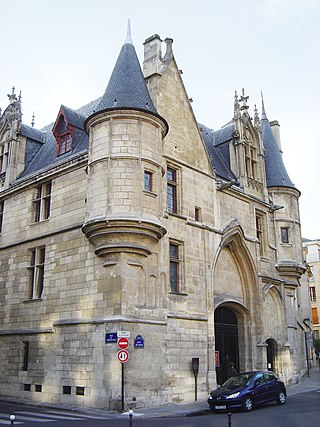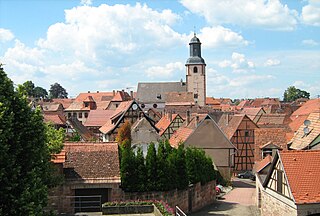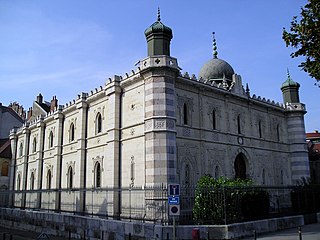
The Marais is a historic district in Paris, France. It spreads across parts of the 3rd and 4th arrondissements on the Rive Droite, or Right Bank, of the Seine. Having once been an aristocratic district, it is home to many buildings of historic and architectural importance. It lost its status as a fashionable district in the late 18th century, with only minor nobles calling the area home. After the French Revolution, the district fell into disrepair and was abandoned by nobility. After a long period of decay, the district has undergone transformation in recent years and is now once again amongst the more fashionable areas of Paris, known for its art galleries, upscale restaurants and museums.

The Petite France, in Alsatian dialect: Französel is the south-western part of the Grande Île of Strasbourg in Alsace in eastern France, the most central and characteristic island of the city that forms the historic center. The district is bounded to the north by the Quai de la Bruche (Brischstade), the Rue du Bain-aux-Plantes, the Place Benjamin-Zix and the Rue des Dentelles; to the east by the Rue du Pont-Saint-Martin, the Pont Saint-Thomas and the Mills footbridge; to the south by the Channel of Zorn-Mühle; to the west by the Covered Bridges.
David Feuerwerker was a French Jewish rabbi and professor of Jewish history who was effective in the resistance to German occupation the Second World War. He was completely unsuspected until six months before the war ended, when he fled to Switzerland and his wife and baby went underground in France. The French government cited him for his bravery with several awards. After the war, he and his wife re-established the Jewish community of Lyon. He settled in Paris, teaching at the Sorbonne. In 1966, he and his family, grown to six children, moved to Montreal, where he developed a department of Jewish studies at the University of Montreal.

The Union Libérale Israélite de France, commonly referred to as the rue Copernic synagogue, is a Reform Jewish congregation and synagogue, located in the XVIe arrondissement of Paris, France. Inaugurated on 1 December 1907, it is the oldest Reform synagogue in France.

Bouxwiller is a commune in the Bas-Rhin department, Alsace, Grand Est, northeastern France. Likely meaning "Bucco's land", Bouxwiller is the capital of the Bouxwiller canton and is located within the Saverne arrondissement about 34 kilometres (21 mi) northwest of Strasbourg.

Herrlisheim is a commune in the Bas-Rhin department in Grand Est in north-eastern France. The town dates from the 8th century. Herrlisheim was the scene of very heavy fighting during Operation Nordwind, an offensive launched by the German Army during World War II that inflicted considerable damage to the town.

Shmuel Trigano is a sociologist, philosopher, professor emeritus of sociology at Paris Nanterre University. He was Tikvah Fund Visiting Professor in Jewish Law and Thought at Benjamin N. Cardozo School of Law, New York (2009), and Templeton Fellow at the Herzl Institute (Jerusalem) program "Philosophy of the Tanakh, Midrash and Talmud" (2012-2013), (2015-2017). Elia Benamozegh European Chair of Sephardic Studies, Livorno, Italy (2002).

The Musée d'Art et d'Histoire du Judaïsme is the largest French museum of Jewish art and history. It is located in the Hôtel de Saint-Aignan in the Marais district in Paris.

The history of the Jews in Alsace is one of the oldest in Europe. It was first attested to in 1165 by Benjamin of Tudela, who wrote about a "large number of learned men" in "Astransbourg"; and it is assumed that it dates back to around the year 1000. Although Jewish life in Alsace was often disrupted by outbreaks of pogroms, at least during the Middle Ages, and reined in by harsh restrictions on business and movement, it has had a continuous existence ever since it was first recorded. At its peak, in 1870, the Jewish community of Alsace numbered 35,000 people.

The Great Synagogue of Europe, formerly known as the Great Synagogue of Brussels, is the main synagogue in Brussels, Belgium, which was dedicated as a focal point for European Jews in 2008.

The beginnings of the history of the Jews in Besançon go back to the Middle Ages, a period during which the Jews settled in the city attracted by its activity as a commercial place. The community was founded at the end of the 14th century and, due to its status as a free imperial city, Besançon remained one of the only territories in present-day France to tolerate Jews after their expulsion from the kingdom of France in 1394. The community was nevertheless expelled in turn from Besançon in the middle of the 15th century. The Jews made a tentative return to the city in the 18th century, but it was only after the French Revolution, which emancipated them, that their situation in the Franche-Comté capital stabilized. Although the Jewish community never exceeded 2,000 people except on the eve of the Second World War, it experienced great economic success during the Industrial Revolution at the end of the 19th century, when the Lipmann family founded LIP, a brand of watchmaking which then became one of the economic engines of the region and remained associated with the name of the city.

The Bischheim Musée du bain rituel juif is a museum in Bischheim, France, in which Jewish bathing rituals were practiced, now recognized as a historical monument in France.

The Synagogue du Quai Kléber was the main synagogue of Strasbourg, France before World War II. It was built in the "Neustadt" when the city was part of the German Empire and destroyed by Nazi Germany after it annexed the city in 1940; in the years between, Strasbourg and its Jewish community were French.

The Place de la République ( is one of the main squares of the city of Strasbourg, France. It is surrounded on three sides by five buildings only, of which none is residential: the Palais du Rhin, the National and University Library, the Théâtre national de Strasbourg, the Préfecture of Grand Est and Bas-Rhin, and the tax center Hôtel des impôts. All of these buildings are classified as monuments historiques. The fourth side of the square is devoid of buildings.

The synagogue of Guebwiller is a Jewish congregation and synagogue, located at 7, rue de l'Ancien-Hôpital, in Guebwiller, Haut-Rhin, France.

The Saint-Avold Synagogue is a Jewish congregation and synagogue, located at the corner of Rue des Americains and Rue de la Mertzelle near Place Paul-Collin in Saint-Avold, in the Moselle department in Grand Est in north-eastern France. The current synagogue building, completed in 1956, replaces a nearby synagogue destroyed during the German occupation of France in World War II.

The Rashi Synagogue is an Orthodox Jewish congregation and synagogue, located on 5 rue Brunneval in Troyes, Grand Est, France. The synagogue is named after the medieval rabbi and biblical commentator Rashi, who was born and died in Troyes. A Sephardic synagogue, it is a member of the Consistoire central israélite de France. The site includes a museum, the Rashi House, a cultural center, and a library. The European University Rashi Institute,, located opposite the synagogue, is a research institute independent of the synagogue focused on Jewish studies, Semitic studies, and Monotheism.

The Rouen Synagogue is an Orthodox Jewish congregation and synagogue, located at 55 rue des Bons-Enfants in Rouen, in the region of Normandy, France. The congregation is affiliated with the Israelite Central Consitory of France, and worships in the Sephardic rite.

Dan Jaffé is a Franco-Israeli specialist in the history of religions and teaches at Bar-Ilan University (Tel-Aviv) and Ashkelon Academic College. He is a researcher attached to the CNRS. His work focuses on the Jewish world in the first centuries of the Common Era, the Talmud and the origins of Christianity. He has published extensively on relations between Rabbinic Judaism and Early Christianity. He directs the collection Judaïsme ancien et christianisme primitif published by Éditions du Cerf.

Judaism in Motion is a Jewish denomination in France. Registered as a French religious association under the 1901 and 1905 French laws on religion, it was founded in 2019 from the merger of the Union libérale israélite de France (ULIF) and the Liberal Jewish Movement of France (MJLF).




















